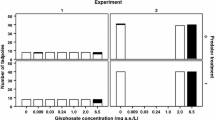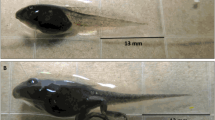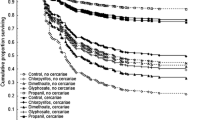Abstract
Amphibian species worldwide are being confronted with novel anthropogenic stressors such as contaminants and invasive species. While much work has been done to examine these factors individually, less is known about how these stressors might interact. No studies to this point have examined the potentially synergistic impacts between these two stressors on a threatened amphibian species. We present the results from three separate laboratory studies focusing on two species of frogs, the Pacific tree frog (Pseudacris regilla) and a federal species of concern, the foothill yellow legged frog (Rana boylii). These experiments examine the toxicity of an insecticide, carbaryl, on each species, on their competitive interactions, and on their interaction with a non-native crayfish predator (Pacifastacus leniusculus). R. boylii were more susceptible to pesticide exposure than P. regilla and exposure reduced their ability to compete. This differential effect of the pesticide resulted in a remarkable increase in mortality (50%) for R. boylii with an invasive crayfish predator present while P. regilla exhibited no change. These results add to concerns over the utility of single species toxicity tests in determining safe levels for environmental exposure and advocate for the use of multiple species tests that focus on key species interactions.







Similar content being viewed by others
References
Bridges, C. M., 1997. Tadpole swimming performance and activity affected by acute exposure to sublethal levels of carbaryl. Environmental Toxicology and Chemistry 16: 1935–1939.
Bridges, C. M., 1999a. Effects of a pesticide on tadpole activity and predator avoidance behavior. Journal of Herpetology 33: 303–306.
Bridges, C. M., 1999b. Predator-prey interactions between two amphibian species: effects of insecticide exposure. Aquatic Ecology 33: 205–211.
Bridges, C. M. & R. D. Semlitsch, 2000. Variation in pesticide tolerance of tadpoles among and within species of Ranidae and patterns of amphibian decline. Conservation Biology 14: 1490–1499.
Boone, M. D. & R. D. Semlitsch, 2001. Interactions of an insecticide with larval density and predation in experimental amphibian communities. Conservation Biology 15: 228–238.
Boone, M. D., R. D. Semlitsch, J. F. Fairchild & B. B. Rothermel, 2004. Effects of an insecticide on amphibians in large-scale experimental ponds. Ecological Applications 14: 685–691.
Bulen, B. J. & C. A. Distel, 2011. Carbaryl concentration gradients in realistic environments and their influence on our understanding of the tadpole food web. Archives of Environmental Contamination and Toxicology 60: 343–350.
Brown, J. R., T. Miiller & J. L. Kerby, 2013. The interactive effect of an emerging infectious disease and an emerging contaminant on Woodhouse’s toad (Anaxyrus woodhousii) tadpoles. Environmental Toxicology and Chemistry 32: 2003–2008.
Caro, T., J. Eadie & A. Sih, 2005. Use of substitute species in conservation biology. Conservation Biology 19: 1821–1826.
Collins, J. P. & A. Storfer, 2004. Global amphibian declines: Sorting the hypotheses. Diversity and Distributions 9: 89–98.
Datta, S., L. Hansen, L. McConnell, J. Baker, J. Lenoir & J. N. Seiber, 1998. Pesticides and PCB contaminants in fish and tadpoles from the Kaweah River Basin, California. Environmental Toxicology and Chemistry 60: 829–836.
Davidson, C., 2004. Declining downwind: Amphibian population declines in California and historical pesticide use. Ecological Applications 14: 1892–1902.
Davidson, C., H. B. Shaffer & M. R. Jennings, 2002. Spatial tests of the pesticide drift, habitat destruction, UV-B, and climate-change hypotheses for California amphibian declines. Conservation Biology 16: 1588–1601.
Distel, C. A. & M. D. Boone, 2011. Insecticide has asymmetric effects on two tadpole species despite priority effects. Ecotoxicology 20: 875–884.
Dodson, S. I., T. Hanazato & P. R. Gorski, 1995. Behavioral responses of Daphnia pulex exposed to carbaryl and Chaoborus kairomone. Environmental Toxicology and Chemistry 14: 43–50.
Gamradt, S. & L. B. Kats, 1995. Effect of introduced crayfish and mosquitofish on California newts. Conservation Biology 10: 1155–1162.
Gherardi, F., 2006. Crayfish invading Europe: the case study of Procambarus clarkii. Marine and Freshwater Behaviour and Physiology 39: 175–191.
Gosner, K., 1960. A simplified table for staging anuran embryos and larvae with notes on identification. Herpetelogica 16: 183–190.
Hopkins, W. A., 2007. Amphibians as models for studying environmental change. ILAR Journal 48: 270–277.
Kats, L. & R. P. Ferrer, 2003. Alien predators and amphibian declines: review of two decades of science and the transition to conservation. Diversity and Distributions 9: 99–110.
Kerby, J. L. & L. B. Kats, 1998. Modified interactions between salamander life stages caused by wildfire-induced sedimentation. Ecology 79: 740–745.
Kerby, J. L. & A. Storfer, 2009. Combined effects of atrazine and chlorpyrifos on susceptibility of the Tiger Salamander to Ambystoma tigrinum virus. Ecohealth 6: 91–98.
Kerby, J., S. Riley, P. Wilson & L. B. Kats, 2005. Barriers and flow as limiting factors in the spread of an invasive crayfish (Procambarus clarkii) in southern California streams. Biological Conservation 126: 402–409.
Kerby, J. L., K. Richards-Hrdlicka, A. Storfer & D. Skelly, 2010. An examination of amphibian sensitivity to environmental contaminants: Are amphibians poor canaries? Ecology Letters 13: 60–67.
Kerby, J. L., A. Wehrmann & A. Sih, 2012. Impacts of the insecticide diazinon on the behavior of predatory fish and amphibian prey. Journal of Herpetology 46: 171–176.
Kupferberg, S., 1997. Bullfrog (Rana catesbeiana) invasion of a California river: the role of larval competition. Ecology 78: 1736–1751.
Little, E. E., R. D. Archeski, B. A. Flerov & V. I. Kozlovskaya, 1990. Behavioral indicators of sublethal toxicity in rainbow trout. Archives of Environmental Contamination and Toxicology 19: 380–385.
Luttbeg, B. & J. L. Kerby, 2005. Are scared prey as good as dead? Trends in Ecology and Evolution 20: 416–418.
Nakata, K., K. Tsutsumi, T. Kawai & S. Goshima, 2005. Coexistence of two North American invasive crayfish species, Pacifastacus leniusculus (Dana, 1852) and Procambarus clarkii (Girard, 1852) in Japan. Crustaceana 78: 1389–1394.
Norris, L. A., H. W. Lorz, and S. Z. Gregory. 1983. Influence of forest and range land management on anadramous fish habitat in western North America: forest chemicals. USDA Forest Service General Technical Report PNW-149.
Pintor, L. M., A. Sih & J. L. Kerby, 2009. Behavioral correlations provide a mechanism for explaining high invader densities and increased impacts on native prey. Ecology 90: 581–587.
Preisser, E. L., D. I. Bolnick & M. F. Benard, 2005. Scared to death? The effects of intimidation and consumption in predator-prey interactions. Ecology 86: 501–509.
Relyea, R. A., 2003. Predator cues and pesticides: a double dose of danger for amphibians. Ecological Applications 13: 1515–1521.
Relyea, R. A., 2004. Growth and survival of five amphibian species exposed to combinations of pesticides. Environmental Toxicology and Chemistry 23: 1737–1742.
Relyea, R. A. & J. T. Hoverman, 2006. Assessing the ecology in ecotoxicology: a review and synthesis in freshwater systems. Ecology Letters 9: 1157–1171.
Relyea, R. A. & N. Mills, 2001. Predator-induced stress makes the pesticide carbaryl more deadly to gray treefrog tadpoles (Hyla versicolor). Proceedings of the National Academy of Sciences 98: 2491–2496.
Rohr, J., J. Kerby & A. Sih, 2006. Community ecology as a framework for predicting contaminant effects. Trends in Ecology and Evolution 21: 607–613.
Schmitz, O. J., A. P. Beckerman & K. M. O’Brien, 1997. Behaviorally mediated trophic cascades: effects of predation risk on food web interactions. Ecology 78: 1388–1399.
Sih, A., A. M. Bell & J. L. Kerby, 2004. Two stressors are far deadlier than one. Trends in Ecology and Evolution 19: 274–276.
Sparling, D. W., G. M. Fellers & L. L. McConnell, 2001. Pesticides and amphibian population declines in California, USA. Environmental Toxicology and Chemistry 7: 1591–1595.
Sparling, D. W. & G. M. Fellers, 2009. Toxicity of two insecticides to california, USA, anurans and its relevance to declining amphibian populations. Environmental Toxicology and Chemistry 28: 1696–1703.
Stuart, S. N., J. S. Chanson, N. A. Cox, B. E. Young, A. S. L. Rodrigues, D. L. Fischman & R. W. Waller, 2004. Status and trends of amphibian declines and extinctions worldwide. Science 5702: 1783–1786.
Weltje, L., P. Simpson, M. Gross, M. Crane & J. R. Wheeler, 2013. Comparative acute and chronic sensitivity of fish and amphibians: a critical review of data. Environmental Toxicology and Chemistry 32: 984–994.
Werner, E. E., 1991. Nonlethal effects of a predator on competitive interactions between two anuran larvae. Ecology 72: 1709–1720.
Werner, E. E. & B. R. Anholt, 1997. Predator-induced behavioral indirect effects: consequences to competitive interactions in anuran larvae. Ecology 77: 157–169.
Acknowledgements
This work was supported by funding from the Environmental Protection Agency. We thank B. Shaffer and M. Johnson for input on previous versions of this manuscript. We also thank A. Lind and S. Kupferberg for assistance with R. boylii. K. Bryant was instrumental in conducting the work. This work was conducted under a permit from the California Department of Fish and Game.
Author information
Authors and Affiliations
Corresponding author
Additional information
Guest editors: Sidinei M. Thomaz, Katya E. Kovalenko, John E. Havel & Lee B. Kats / Aquatic Invasive Species
Rights and permissions
About this article
Cite this article
Kerby, J.L., Sih, A. Effects of carbaryl on species interactions of the foothill yellow legged frog (Rana boylii) and the Pacific treefrog (Pseudacris regilla) . Hydrobiologia 746, 255–269 (2015). https://doi.org/10.1007/s10750-014-2137-5
Received:
Revised:
Accepted:
Published:
Issue Date:
DOI: https://doi.org/10.1007/s10750-014-2137-5




